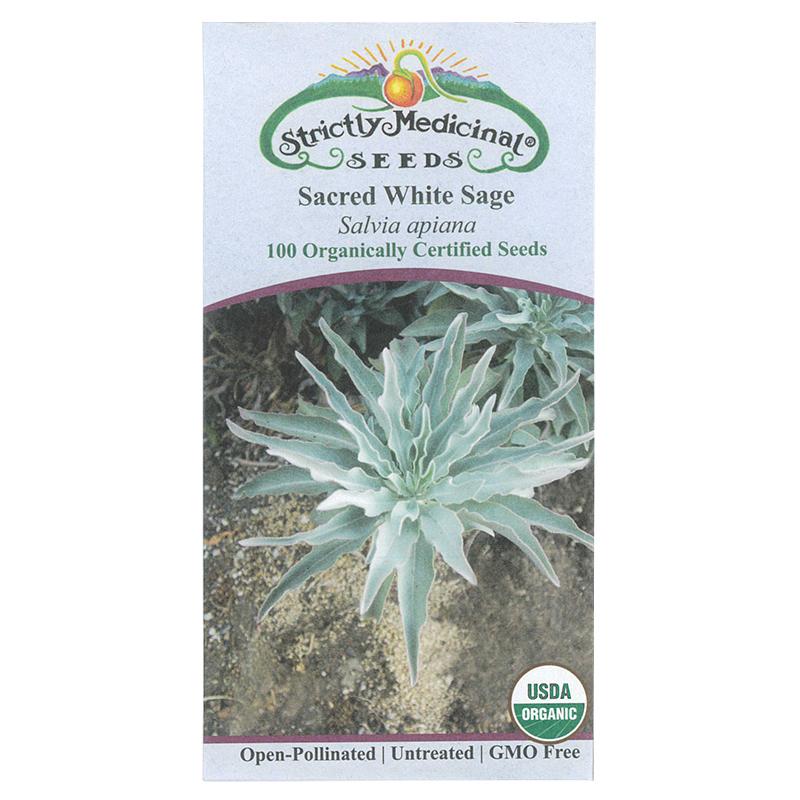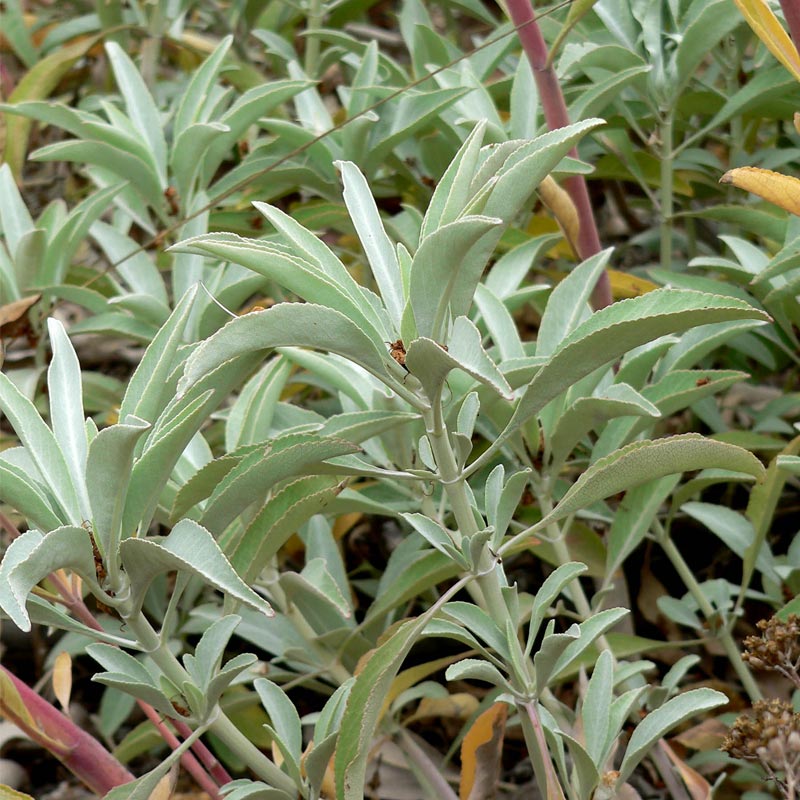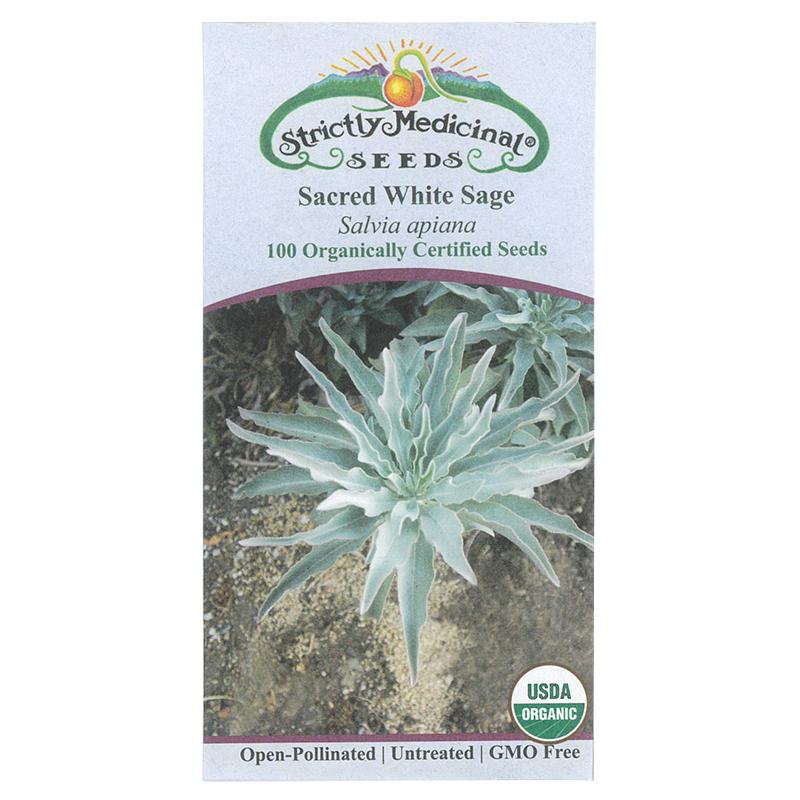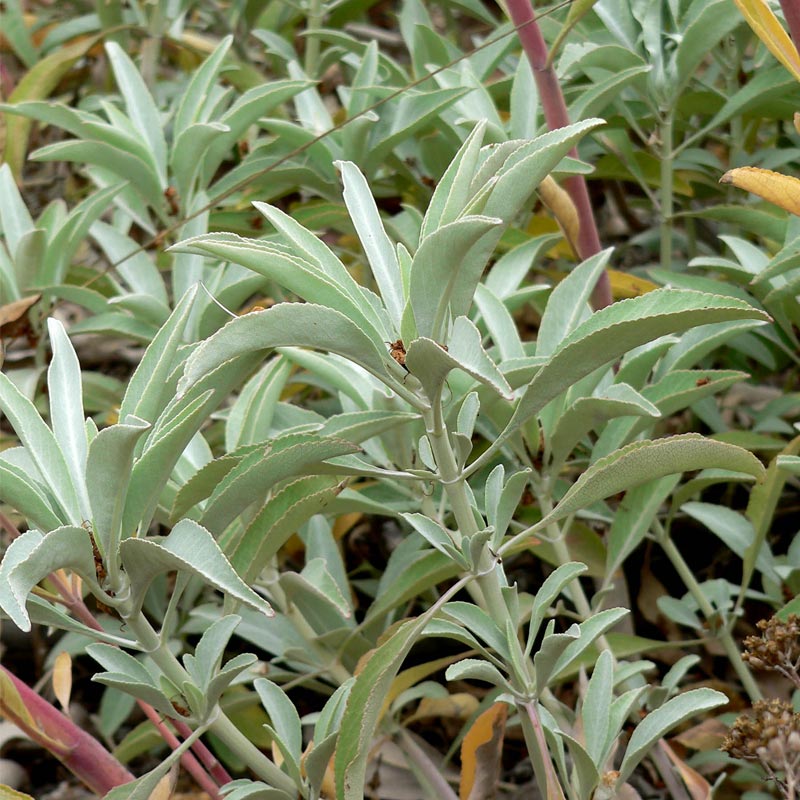Item Number: SNV7016
White Sage Seeds (Organic)
White Sage Seeds (Organic)
Highly Valued North American Sage
White Sage - Salvia apiana
Perennial. White foliage of this indigenous plant sets off the silver-blue flowering spikes. Most highly valued of North American Sages. Protect from cold, wet conditions.
Approximately 100 seeds per pack.
Photo by Stan Shebs.
White Sage (Salvia apiana) is a revered and versatile herb known for its spiritual significance and medicinal properties*. If you're interested in cultivating this remarkable plant, you can start by obtaining White Sage seeds.
Introduction to White Sage (Salvia apiana)
White Sage, scientifically known as Salvia apiana, is a perennial evergreen shrub native to the southwestern United States and northwestern Mexico. It belongs to the Lamiaceae family, which includes other well-known herbs like mint and oregano. White Sage is characterized by its silvery-white leaves, fragrant aroma, and tall spikes of small, white flowers.
Cultural and Spiritual Significance
White Sage holds deep cultural and spiritual significance for many indigenous communities in North America, particularly among Native American tribes. It is commonly used in smudging ceremonies, where the dried leaves are burned to cleanse and purify the surrounding space. This practice is believed to rid the area of negative energy and promote spiritual harmony.
Medicinal Properties
Apart from its ceremonial use, growers have been interested in White Sage for reported medicinal benefits*. Some traditional uses of White Sage include:
Respiratory Health: White Sage leaves are used to prepare herbal remedies that can alleviate respiratory issues such as coughs, colds, and sore throats. The leaves contain compounds with expectorant and anti-inflammatory properties.
Antioxidant Effects: White Sage contains antioxidants that help protect the body's cells from oxidative stress, potentially reducing the risk of chronic diseases.
Anti-Inflammatory: The plant's compounds may also have anti-inflammatory properties, making it valuable for addressing various inflammatory conditions.
Antibacterial: White Sage has been used historically to treat minor skin infections and wounds due to its natural antibacterial properties.
Growing White Sage from Seeds
To grow White Sage from seeds successfully, it's essential to understand its growth requirements:
Climate: White Sage thrives in arid and semi-arid climates. It prefers full sun and well-drained soil. If you live in an area with harsh winters, consider growing it in pots that can be brought indoors during the colder months.
Seed Starting: White Sage seeds can be sown directly in the garden or started indoors in pots. Starting seeds indoors allows for better control of temperature and moisture during germination. The seeds should be planted at a depth of 1/8 inch in a well-draining seed starting mix.
Germination: White Sage seeds typically germinate within two to three weeks, but it may take longer in some cases. Keep the soil consistently moist but not waterlogged during this period.
Transplanting: Once the seedlings have grown to a manageable size, they can be transplanted into the garden or larger containers. Space them at least 24 inches apart to allow for their mature size.
Maintenance: White Sage is relatively low-maintenance. It requires minimal watering once established and benefits from occasional pruning to encourage bushier growth.
White Sage seeds offer the opportunity to cultivate a plant with rich cultural and spiritual significance, as well as valuable medicinal properties. Whether you plan to use it for smudging ceremonies or harness its healing potential, growing White Sage from seeds can be a rewarding experience. By providing the appropriate growing conditions and care, you can enjoy the beauty and benefits of this remarkable herb in your own garden.
* See a physician for health and medicinal matters.


Check Your Zone Compatibility:
Compatible with your zone.
Growing Zone for
,

Our Guarantee To You
Since 1976, we've served our customers at every stage of growing. Please contact us at any time. We are happy to support and assist you.
Description
Description
White Sage - Salvia apiana
Perennial. White foliage of this indigenous plant sets off the silver-blue flowering spikes. Most highly valued of North American Sages. Protect from cold, wet conditions.
Approximately 100 seeds per pack.
Photo by Stan Shebs.
White Sage (Salvia apiana) is a revered and versatile herb known for its spiritual significance and medicinal properties*. If you're interested in cultivating this remarkable plant, you can start by obtaining White Sage seeds.
Introduction to White Sage (Salvia apiana)
White Sage, scientifically known as Salvia apiana, is a perennial evergreen shrub native to the southwestern United States and northwestern Mexico. It belongs to the Lamiaceae family, which includes other well-known herbs like mint and oregano. White Sage is characterized by its silvery-white leaves, fragrant aroma, and tall spikes of small, white flowers.
Cultural and Spiritual Significance
White Sage holds deep cultural and spiritual significance for many indigenous communities in North America, particularly among Native American tribes. It is commonly used in smudging ceremonies, where the dried leaves are burned to cleanse and purify the surrounding space. This practice is believed to rid the area of negative energy and promote spiritual harmony.
Medicinal Properties
Apart from its ceremonial use, growers have been interested in White Sage for reported medicinal benefits*. Some traditional uses of White Sage include:
Respiratory Health: White Sage leaves are used to prepare herbal remedies that can alleviate respiratory issues such as coughs, colds, and sore throats. The leaves contain compounds with expectorant and anti-inflammatory properties.
Antioxidant Effects: White Sage contains antioxidants that help protect the body's cells from oxidative stress, potentially reducing the risk of chronic diseases.
Anti-Inflammatory: The plant's compounds may also have anti-inflammatory properties, making it valuable for addressing various inflammatory conditions.
Antibacterial: White Sage has been used historically to treat minor skin infections and wounds due to its natural antibacterial properties.
Growing White Sage from Seeds
To grow White Sage from seeds successfully, it's essential to understand its growth requirements:
Climate: White Sage thrives in arid and semi-arid climates. It prefers full sun and well-drained soil. If you live in an area with harsh winters, consider growing it in pots that can be brought indoors during the colder months.
Seed Starting: White Sage seeds can be sown directly in the garden or started indoors in pots. Starting seeds indoors allows for better control of temperature and moisture during germination. The seeds should be planted at a depth of 1/8 inch in a well-draining seed starting mix.
Germination: White Sage seeds typically germinate within two to three weeks, but it may take longer in some cases. Keep the soil consistently moist but not waterlogged during this period.
Transplanting: Once the seedlings have grown to a manageable size, they can be transplanted into the garden or larger containers. Space them at least 24 inches apart to allow for their mature size.
Maintenance: White Sage is relatively low-maintenance. It requires minimal watering once established and benefits from occasional pruning to encourage bushier growth.
White Sage seeds offer the opportunity to cultivate a plant with rich cultural and spiritual significance, as well as valuable medicinal properties. Whether you plan to use it for smudging ceremonies or harness its healing potential, growing White Sage from seeds can be a rewarding experience. By providing the appropriate growing conditions and care, you can enjoy the beauty and benefits of this remarkable herb in your own garden.
* See a physician for health and medicinal matters.
Shipping Information
Shipping Information
Shipping Weight: 0.01 lb
Dimensions: 5.0"L x 2.625"W x 0.1"H
Features
Features
- Attracts Bees/Butterflies
- Cold Hardy
- Does Not Require Support
- Down to 25°F
- Drought Tolerant
- Good for Drying
- Open-Pollinated
- Plant Spreads
- Requires Summer Water
- Somewhat Drought Tolerant
- Suited to Warmer Climates
Characteristics
Characteristics
Planting & Care
Planting & Care
Soil & Water:Thrives in sunny, sandy, dry to mesic well drained soil. Protect from cold or wet conditions.
Planting & Growing:Sow on surface of soil and barely cover, tamp firmly and keep warm, barely moist and in the light until germinated (up to 6 weeks). Fire treatment helps with germination rate. Space 3 feet apart of keep in shallow, wide pots.
Harvesting & Storage: Harvest flowering tops in the early morning. Wait until second year to harvest.
Useful Information
Useful Information
Guarantee
Guarantee
Share






